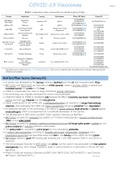BioNTech/Pfizer Vaccine (Germany/US)
→ A vaccine was developed by the German company BioNTech and the US pharmaceutical giant Pfizer.
→ BNT162b1 and BNT162b2 are examples of mRNA vaccines, where a synthetic mRNA is injected and
translated quickly into protein by the host.
→ mRNA is a reasonably new class of drugs that deliver genetic information
→ the technology was originally developed for cancer immunotherapies.
→ Treatment based on mRNA is considered safe because the RNA is transiently expressed, metabolized
quickly and does not integrate into the host genome.
→ Lately, modifications of the mRNA with 1-methylpseudouridine has resulted in a longer lived antibody
response, while packaging the mRNA into liquid nanoparticles serves as protection from degradation.
→ An additional strength of this technology is the ability to quickly produce large amounts of vaccine against
novel pathogens, which is a requirement for a worldwide distribution of the vaccine.
→ The development of BNT162b1 and BNT162b2 started in Germany at BioNTech.
→ BNT162b1 encodes the trimerized (by addition of T4 fibritin folding domain) receptor binding domain
(RBD) of the spike protein.
→ BNT162b2 encodes the prefusion stabilized membrane-anchored full length spike protein, modified by two
proline mutations to maintain prefusion conformation.
→ The spike protein is considered a prime target for virus neutralizing antibodies.
→ A cationic lipid nanoparticle consisting of ionizable amino lipid, phospholipid, cholesterol and a
polyethylene glycol-lipid was described earlier and aids in the delivery of the mRNA into the cytosol.
→ BNT162b1 elicited a good RBD-binding IgG antibody and T cell (RBD-specific CD8(+) and CD4(+))
response.
→ The immunological response to BNT162b2 was similar, but this vaccine was associated with less systemic
reactogenicity (e.g., fever, fatigue, headache, grade 4 severe reactions) in particularly in the 65–85 year
age group.
→ Phase I/II trials are ongoing in Germany for BNT162b1/BNT162b2 (NCT04380701) and China for
BNT162b1 (NCT04523571). TJW Notes
, → NCT04368728 is a phase I/II/III trial that tests BNT162b1 and BNT162b2 with 43,448 participants.
→ In several groups, participants between the age of ≥12 years up to 85 years were tested, two doses were
given by intramuscular injection.
→ Local and systemic reactions were monitored, SARS-CoV-2 serum neutralizing antibodies were measured, as
well as anti-RBD binding antibody levels.
→ Two doses of BNT162b1, administered to 45 adults between the ages of 18 and 55 demonstrated that
the vaccine resulted in robust immunogenicity.
→ Seven days after a second dose of 30 µg of BNT162b1, given 21 days after the first dose, RBD-binding
IgG increased to 27,872 U/mL and persisted for another week.
→ In comparison, human convalescent sera only contained 602 U/mL of RDB-binding IgG.
→ Likewise, SARS CoV-2 neutralizing titers reached 437 at 14 days after the second dose of 30 µg, as
compared to 94 from human convalescent sera.
→ Symptoms included mild to moderate pain at the injection site and mild to moderate fatigue and headache.
Most these reactions improved after two days.
→ The phase III trial component of NCT04368728 identified eight cases of COVID-19 in participants that
had received BNT162b2 and 162 cases among the participants that had received the placebo.
→ This was considered 95% effectiveness. BioNTech/Pfizer have recently received emergency use
authorization (EUA) from the FDA [40] and approval by the UK.
→ Pfizer has contracts with the US, EU, UK, Japan, Canada, and Australia.
→ Rollout of the vaccine has started
Oxford/Astra Zeneca Vaccine (UK/US)
→ The design for the AZD1222 (ChAdOx1 nCOV-19) vaccine by the University of Oxford in the UK and Astra
Zeneca in Cambridge, UK is fundamentally different from the mRNA vaccines.
→ Instead of using mRNA and a nanoparticle, this vaccine is based on a replication deficient chimpanzee
adenovirus.
→ Viral vectors have been used for the development of vaccines for several decades and are characterized by
a strong CD4+ and CD8+ response even in the absence of an adjuvant, which makes them a suitable
vaccine vector for pathogenic viruses that elicit a strong cellular immune response.
→ In addition to human adenoviruses (e.g., Ad5, Ad26), simian adenoviruses have been used because of the
reduced seroprevalence in the human population, leading to reduced pre-existing immunity.
→ AZD1222 is based on the ChAdOx1 chimpanzee adenovirus, which carries deletions in the early genes E1
and E3 that are intended to inhibit replication and permitting for the integration of large pieces of genetic
information.
→ The integrated gene encodes the full length spike protein in its glycosylated form and includes a tissue
plasminogen activator leader sequence.
→ A single dose induced antibody and T cell responses in mice and pigs, while a second immunization
increased virus neutralizing titers in pigs.
→ In macaques, the vaccine induced a balanced humoral and cell-mediated immune response and reduced viral
load; pneumonia was reduced in vaccinated and consecutively infected animals.
→ A phase I/II clinical trial (NCT04324606) with 1077 participants demonstrated that adverse effects of the
vaccine, administered intramuscularly, were mild to moderate and included fever, headaches, body pain and
malaise that could be suppressed with paracetamol.
→ The T cell response peaked on day 14, the IgG antibody response at day 28.
→ The latter was further improved by a second immunization.
→ Neutralization response occurred in 91% of the participants after one immunization and 100% after the
second boost.
→ The phase II component from the phase II/III trial NCT04400838 was published and contained data from
560 participants.
→ Adverse effects were similar to the ones reported previously, but less severe in older participants than in
young ones.
TJW Notes





